








Yak Weeks - Down Memory Lane - Yak Week 2009 - part 4 of 4By Brian Spurr 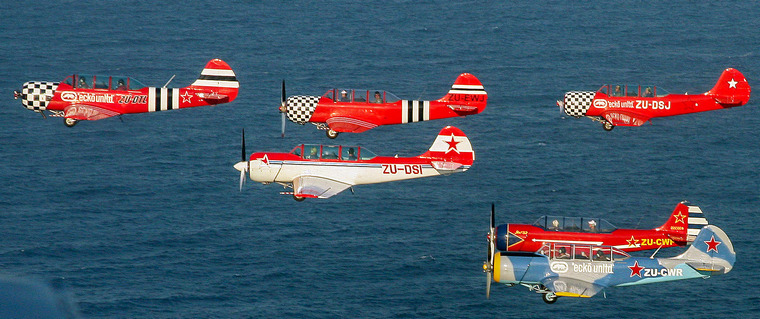 That year, there was no photograph taken of all the pilots and instructors from Yak Week. This shot however, has most of the pilots and some of the instructors. Joining them are pilots from the Flying Lions Aerobatic Team and from the L39 display aircraft, who were preparing for the air show at the weekend. 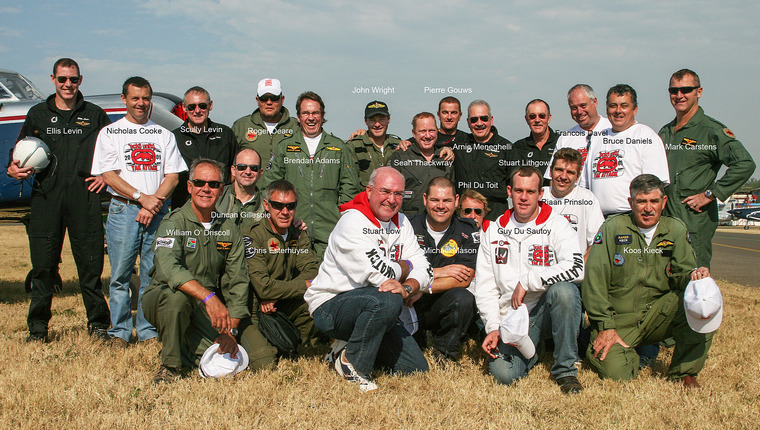 The participants After the Yak Week programme the formation flew in the Friday validation session and the air show that weekend. The air show was sponsored by the City of Durban. The Silver Falcons were back acting as instructors. They arrived the week prior to the Durban Airshow and were thus able to participate in both events. Once more, Stuart Low was in charge of operations and Acher Aviation's offices became the base for briefing and de-briefing. The popular formation flying training event was once more based on the courses run in England, at North Weald Airfield. 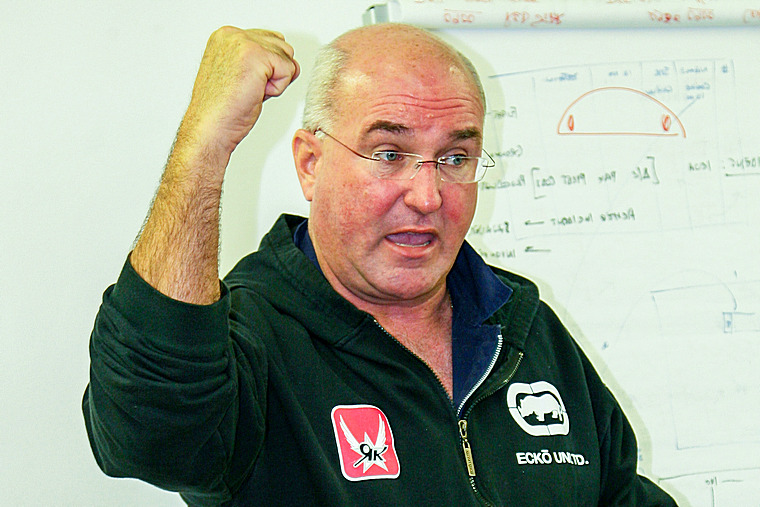 Stuart Low lays down the law, leading the pre-flight briefing! 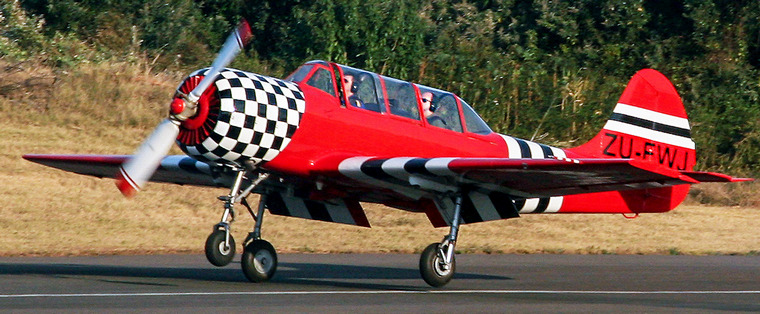 Brendan Adams - ZU-BHR - Yak 18T - Durban. 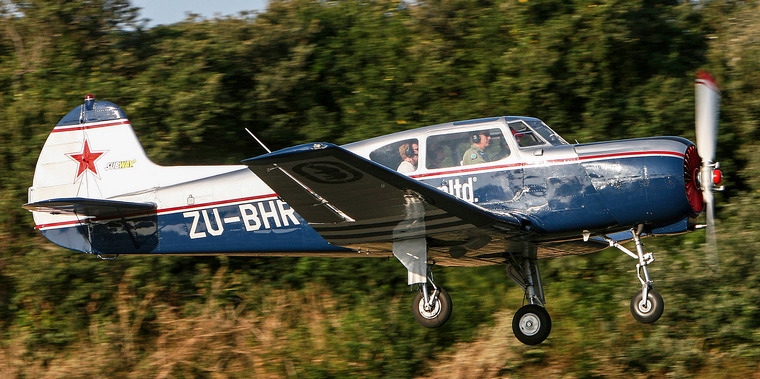 Phil Du Toit - ZU-CWP - Yak 52 - Durban. 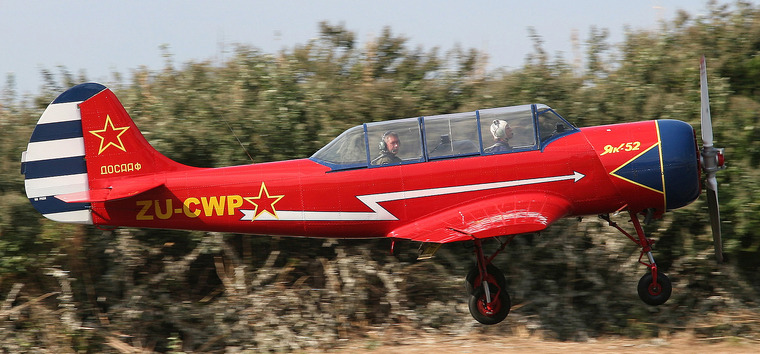 Roger Deare - ZU-CWR - Yak 52 - Durban. 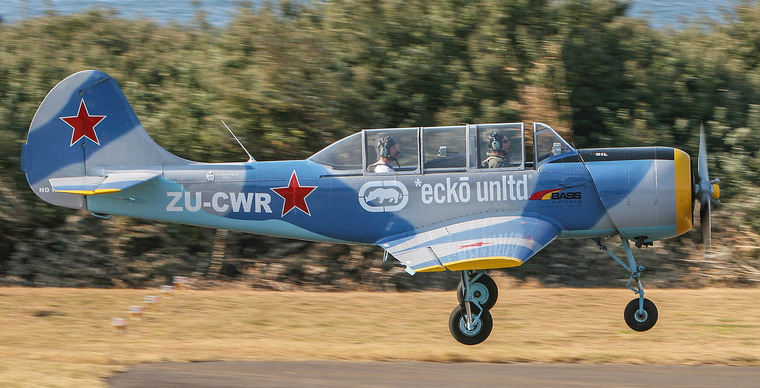 Francois Davel - ZU-DGD - Yak 18T - Howick. 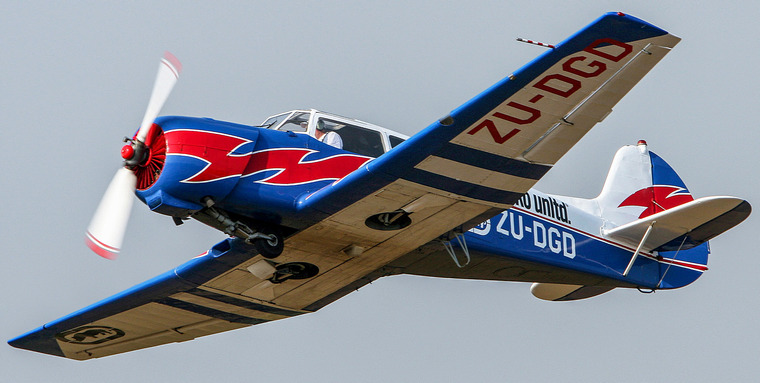 Bruce Daniels - ZU-DSI - Yak 52 - Durban. (shared) 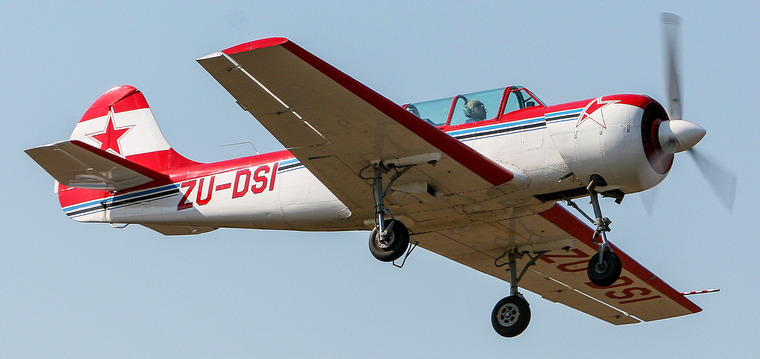 Nick Cooke - ZU-DSI - Yak 52 - Durban. (shared) 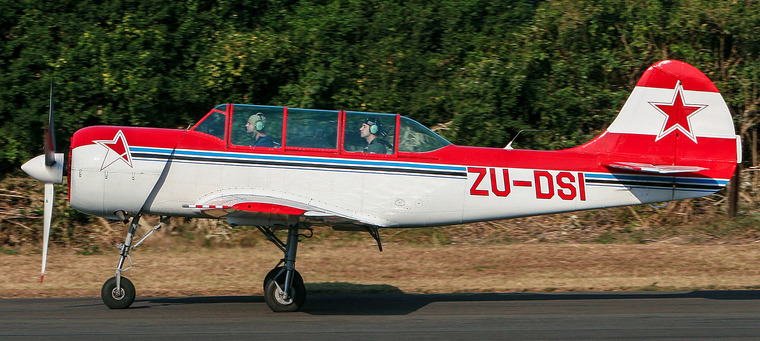 Alan Wight - ZU-DSJ - Yak 52 - Cape Town (shared). This time he left his 18T in Cape Town. 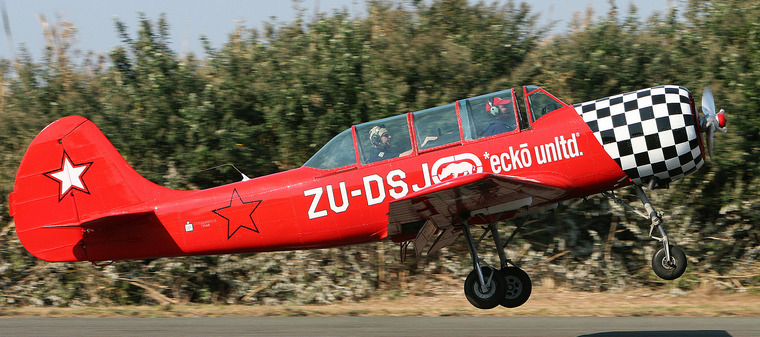 William O'Driscoll - ZU-DSJ - Yak 52 - Durban. (shared) 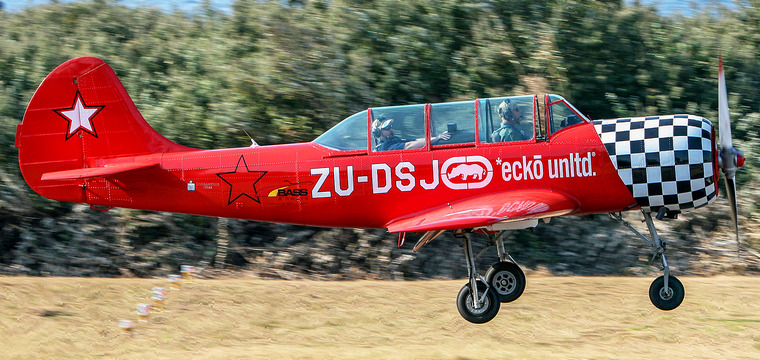 Mark Carstens - ZU-DTL - Yak 52 - Durban. (shared) 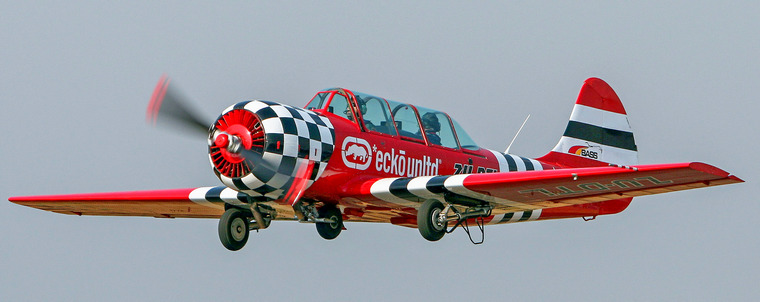 Barrie Kruger - ZU-DTL - Yak 52 - Durban. (shared) 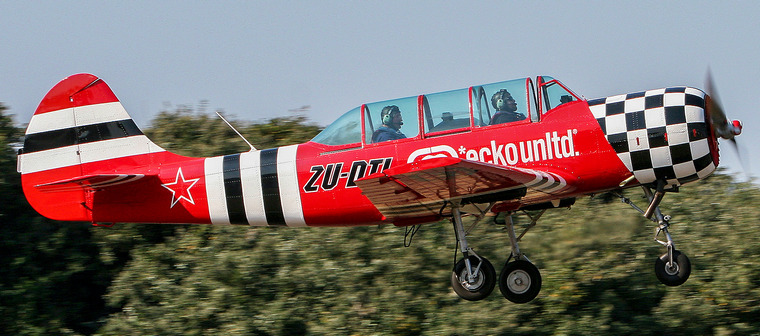 As can be seen, the 2009 event was primarily a KZN affair as far as the pilot group (doing the formation course), was concerned. The exception was Capetonian Alan Wight who was back for the third time. There were three pilots who had attended all four Yak Weeks namely, Roger Deare, Francois Davel and Riaan Prinsloo (Riaan left the 2007 week early.) 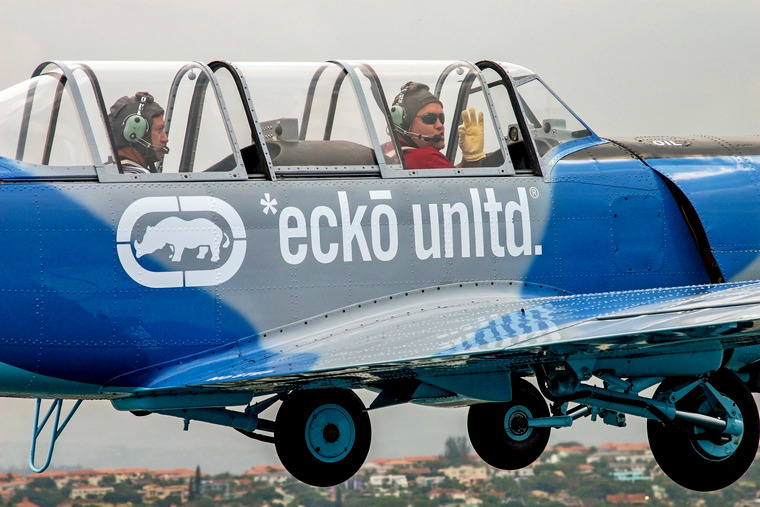 Roger Deare looking happy with Chris Esterhuyse 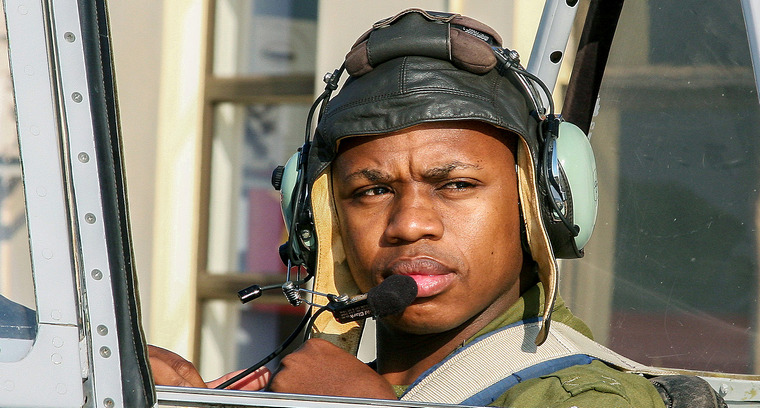 Buti Tsebe ready to go out. 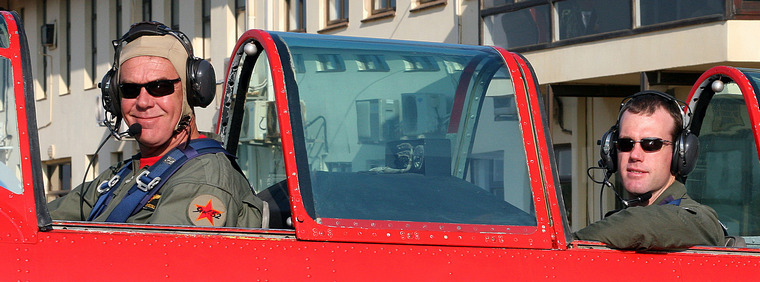 William O'Driscoll and Guy Du Sautoy. 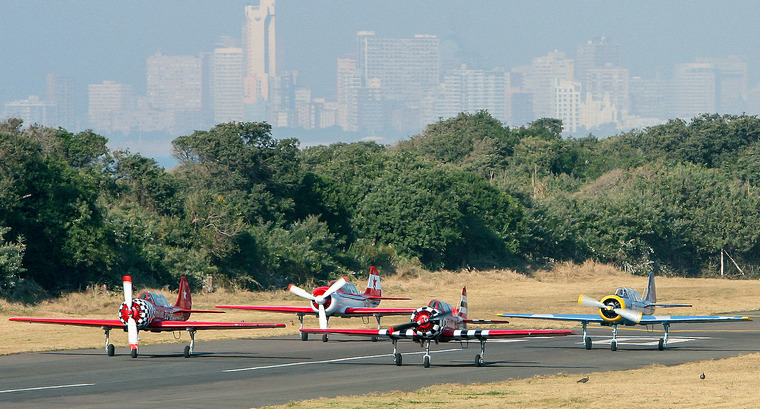 Four 52s line up with the Durban skyline behind. 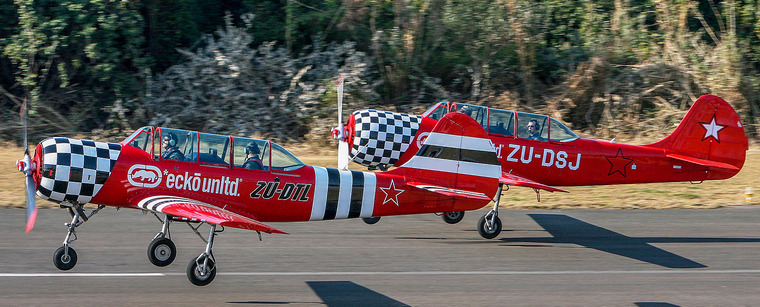 Formation take off by Mark Carstens and William O'Driscoll Most pilots were back for the second or third time, but there were a couple of first timers too. Virginia was action packed the whole week. Yak Week was in full swing and aircraft were arriving for the air show. As in previous years the week started with smaller formations of two or three aircraft flying sorties twice a day. 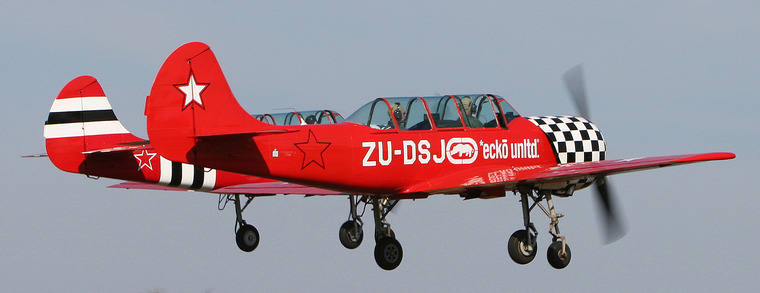  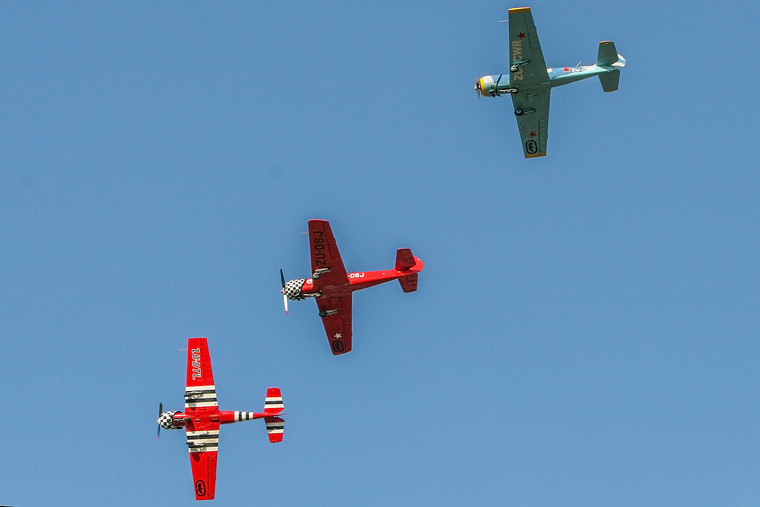 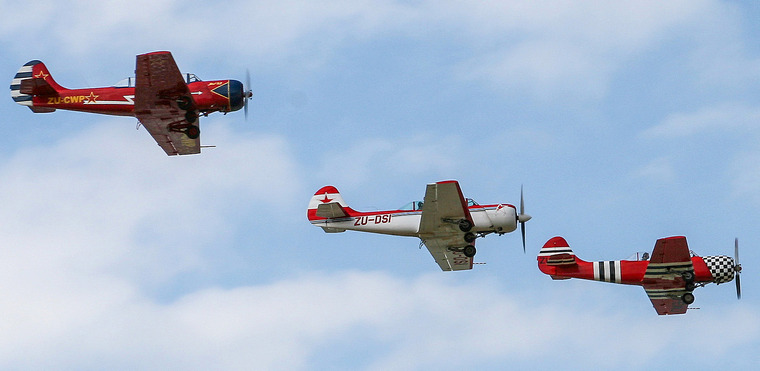 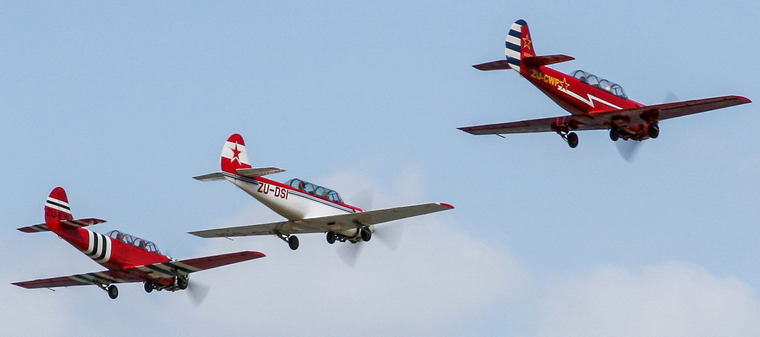 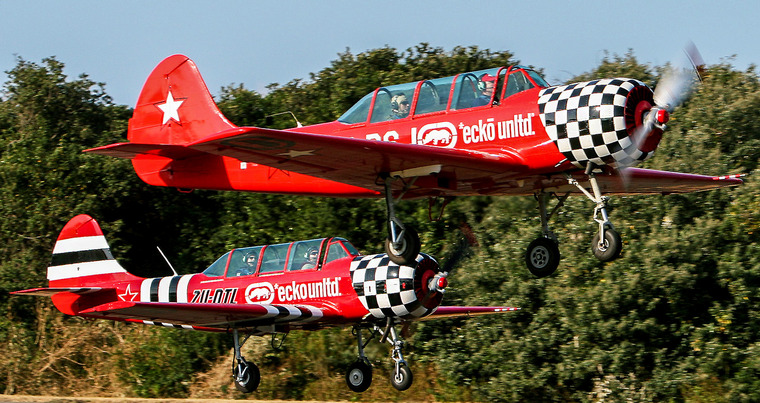 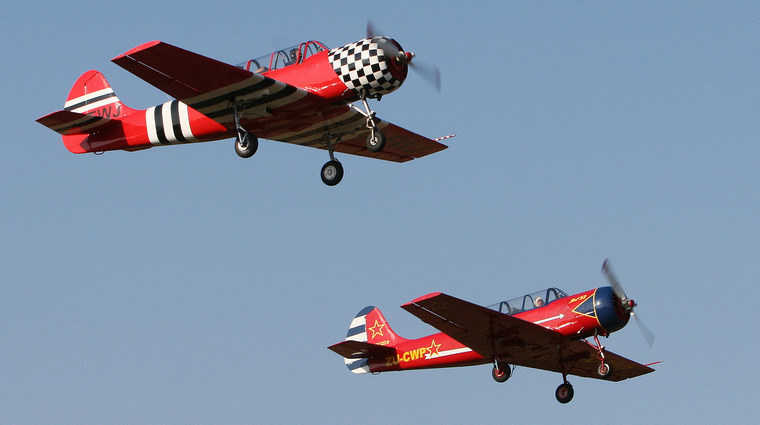 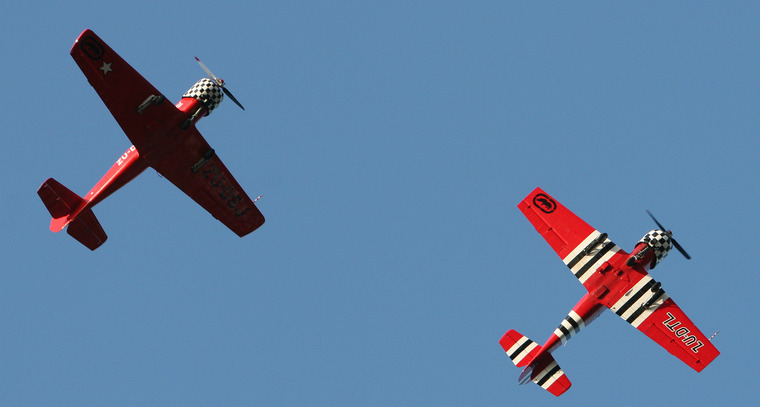  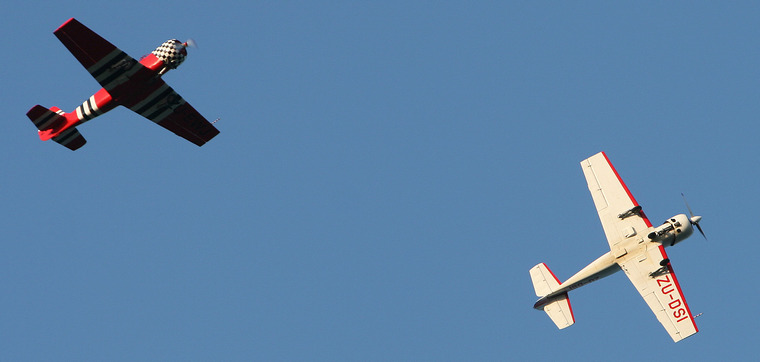 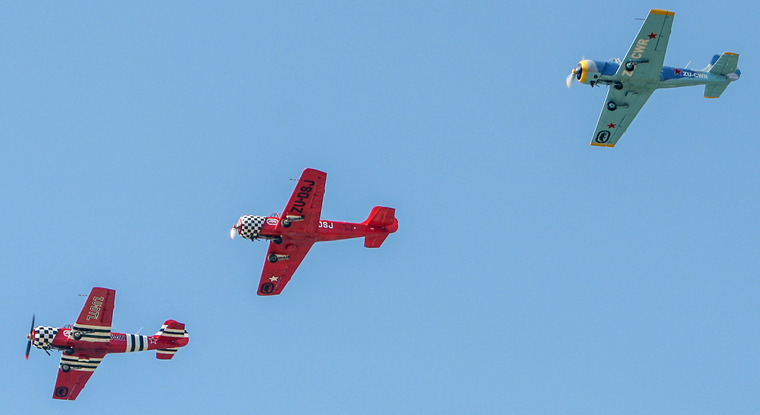 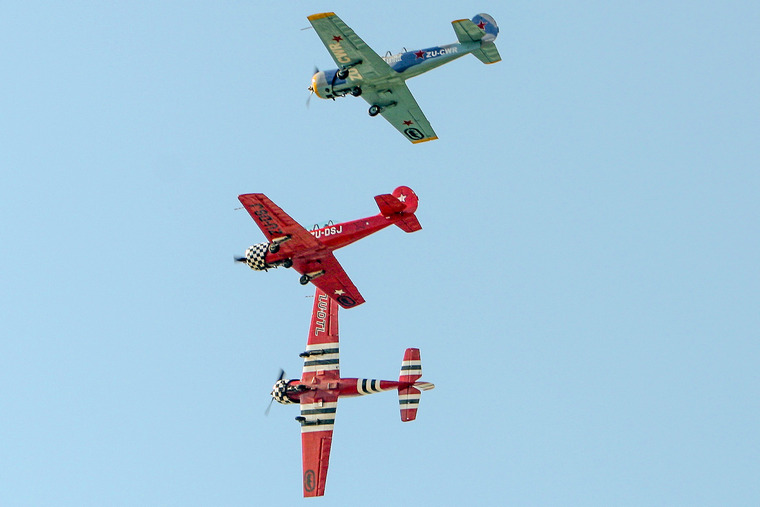 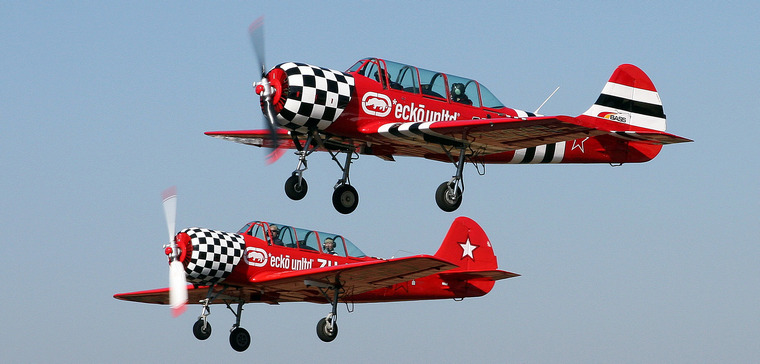 The end of training culminated in an eight-ship formation over North Durban with six Yak 52s and two Yak 18Ts. 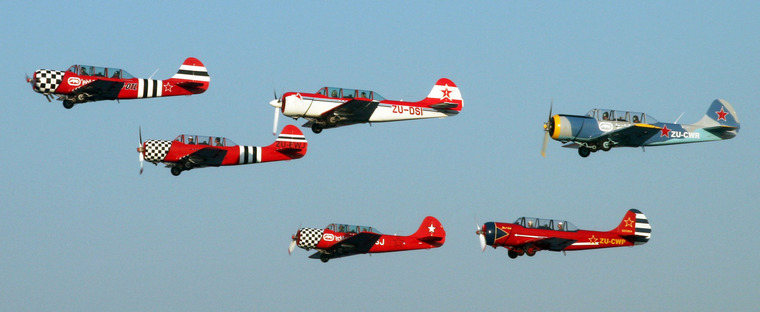 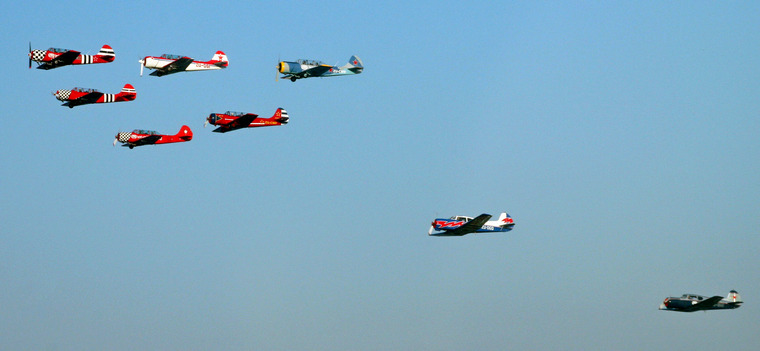 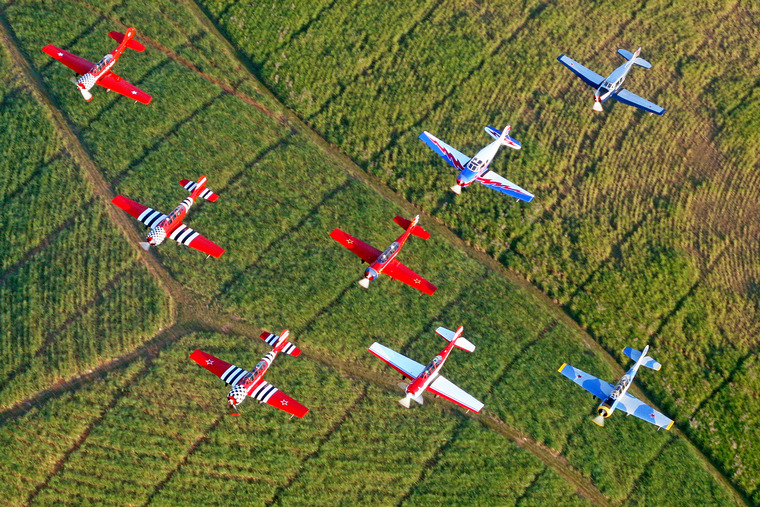 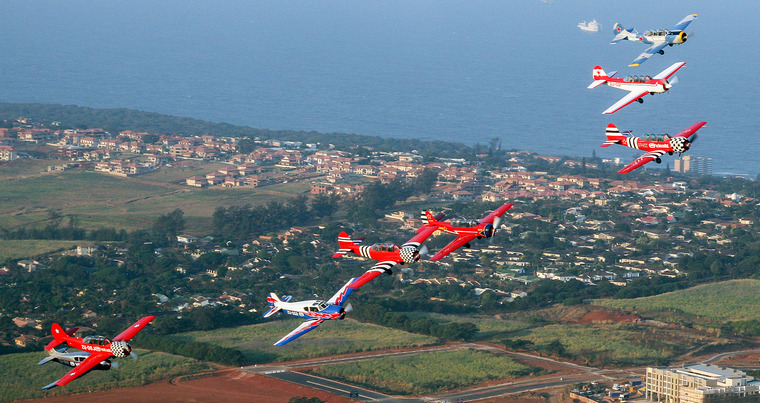 On Friday, the 10th validations were flown for the air show on Saturday the 11th. The team flew in the Durban Air Show on Saturday. This was another unique experience as the team took part in a big sixteen-ship radial engine fly past with eight Harvards. After the fly past the two groups split and each did their own routine. The team was billed as “Yak Attack” in the air show programme! 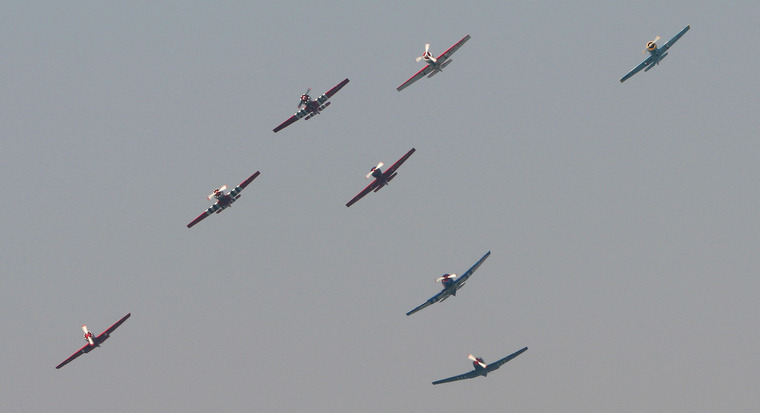 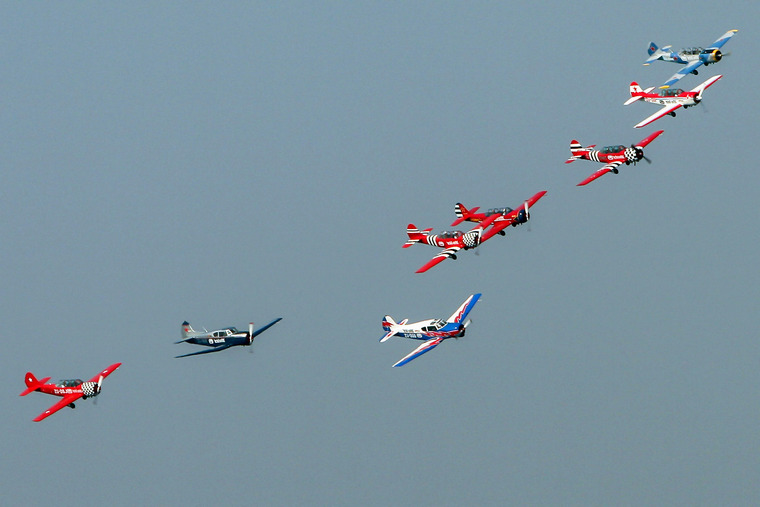  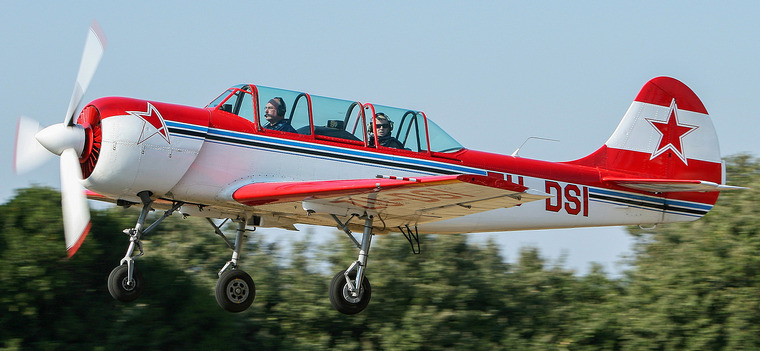 Stuart Low in the Yak 52. 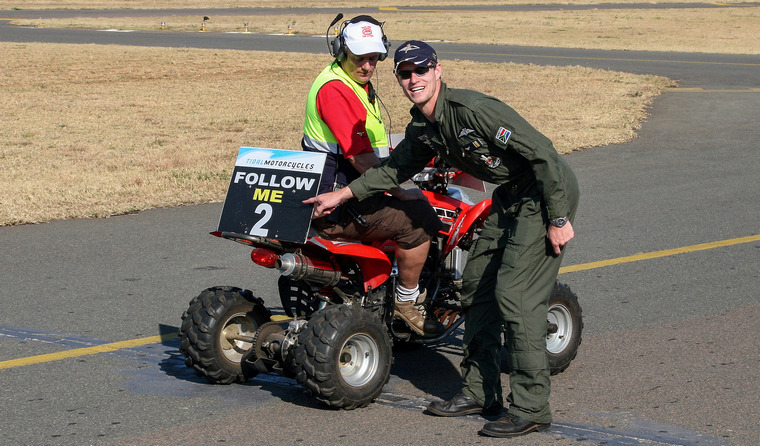 Ground handler Gary Joubert with Scott Ternent. As had become the norm, the standard of instructors was out of the top drawer. Ten in all, they were led as already mentioned by Stuart Low of Acher Aviation. Chris Esterhuyse, also of Acher assisted him. Stuart and Chris participated in all four Yak Weeks. The Silver Falcons were back and this time represented by their leader Scott Ternent, Gerhard Lourens, Buti Tsebe and WJ Englebrecht. They were joined by ex-Falcon Guy de Sautoy. 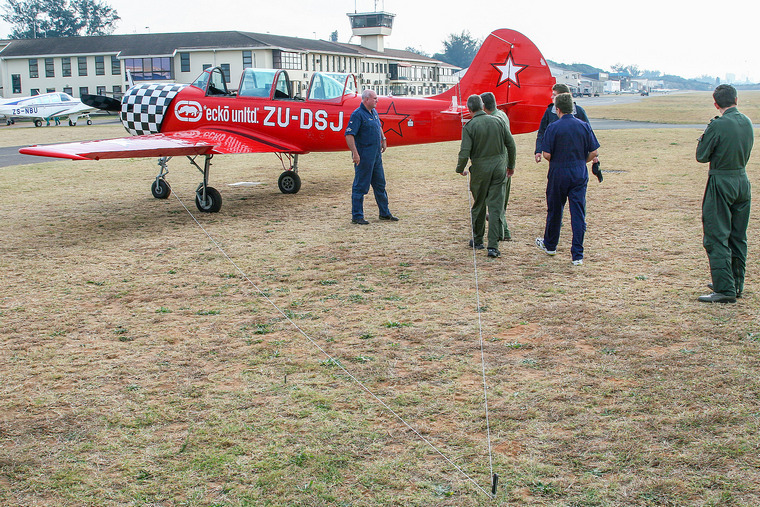 Pilots being taught the correct sight lines to use to maintain a tight formation. 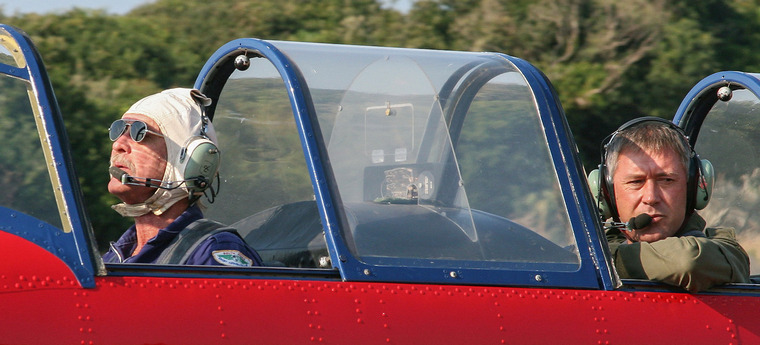 Phil Du Toit goes out with Chris Esterhuyse. 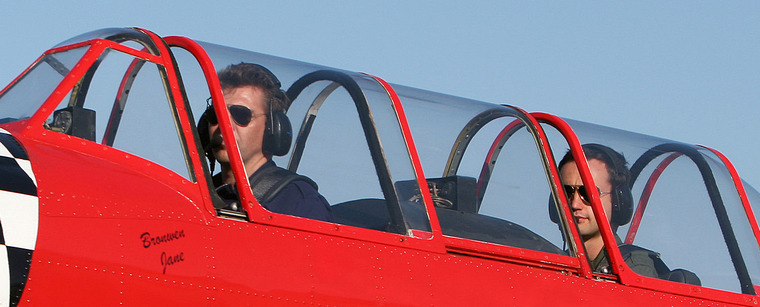 Riaan Prinsloo in the 52 with Silver Falcon WJ Englebrecht. 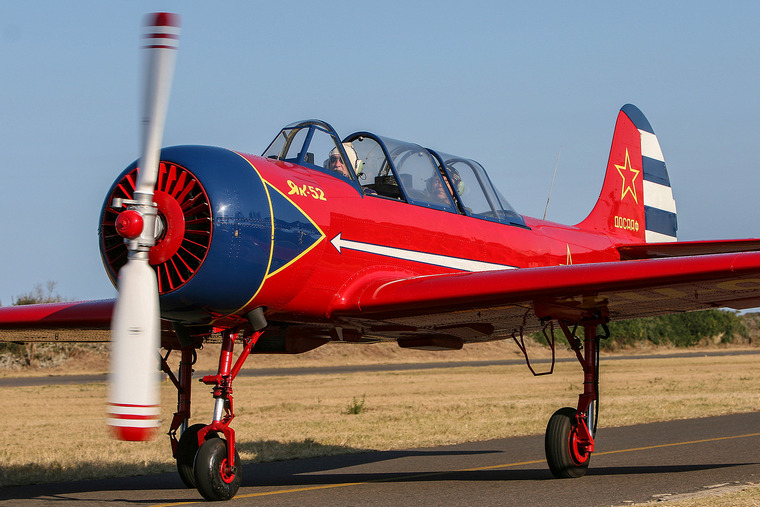 Phil Du Toit and Gerhard Lourens. 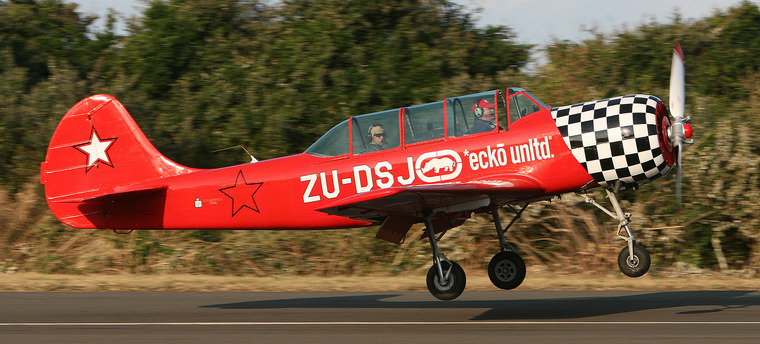 Alan Wight takes to the skies. The other instructors were ex-SAAF corporate Boeing pilot Duncan Gillespie, ex-SAAF pilot Koos Kieck and ex-SAAF and SA Express pilot Mike Mason. 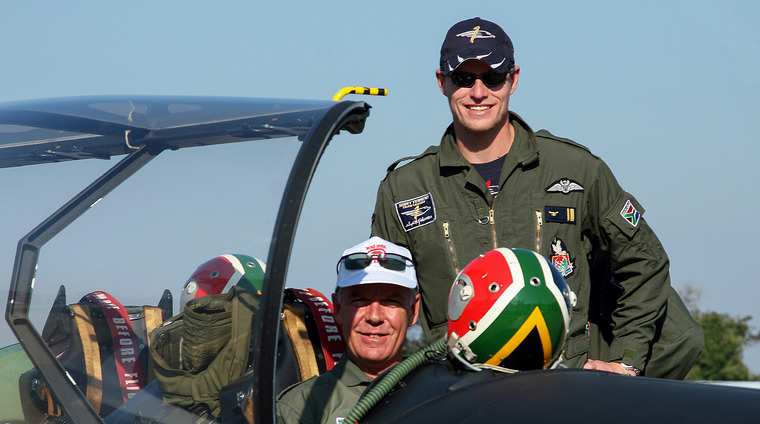 Scott Ternent shows William O' Driscoll his regular workplace in the Astra 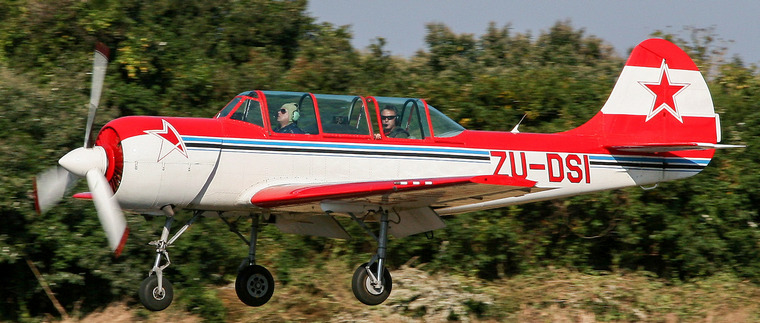 Bruce Daniels comes in to land with Chris Esterhuyse. 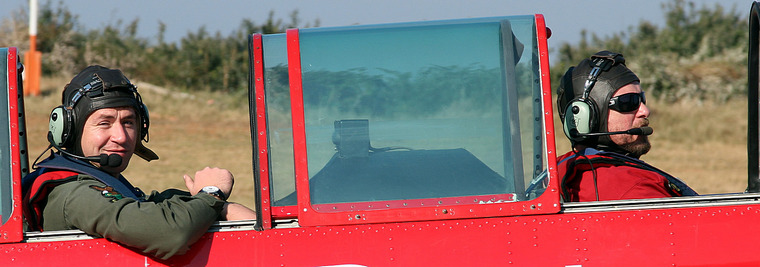 Barrie Kruger and Gerhard Lourens. 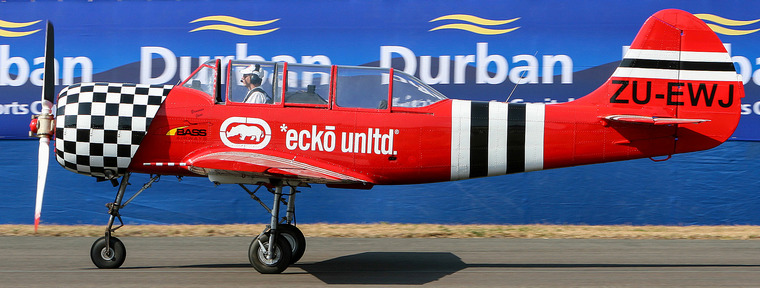 Riaan Prinsloo on air show day. Again, this year, the writer had the opportunity to fly with the Yaks. Several sorties were flown in the 18T's and 52's and one in a Bonanza camera ship, flown by Stuart Low. The latter flight was the first flown by the eight-ship and part of the flight happened over the new King Shaka airport. The airport was in the construction phase prior to opening in time for the 2010 World Cup football tournament. 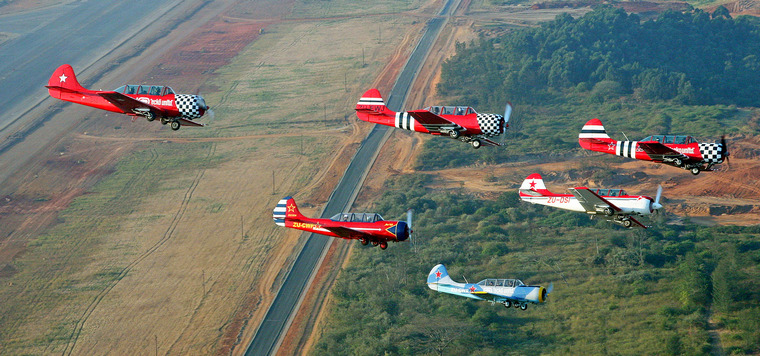 The other flight of note was in a Yak 52 flown by Riaan Prinsloo. It was a unique opportunity as the plan was to formate with three of the Silver Falcons PC-7 Mk II Astras that were arriving from Cape Town on Wednesday. There was one problem:- the flight took off as the sun was setting (17h11 in midwinter Durban) so this photographer had to max out ISO and reduce the shutter speed to get any image at all. The resulting poor-quality photo (below), is reproduced as a record of this unusual event and was captured at 17h32 (it was very dark). The image demonstrates the tight formation of the Falcons. The Yak pilots were accompanied by Silver Falcon instructors. 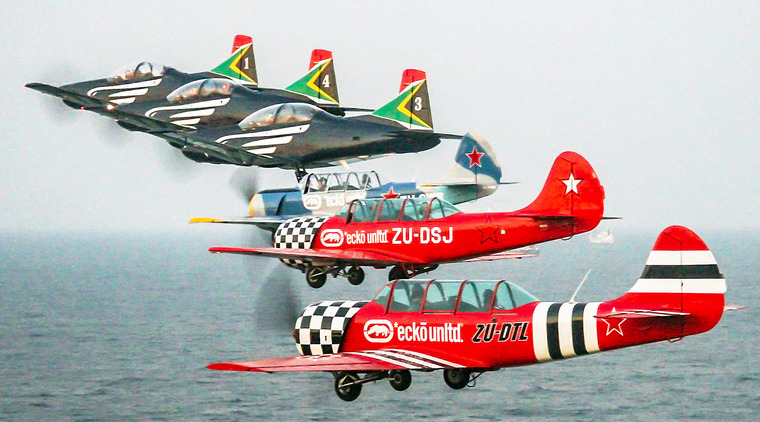 Another flight prior to the air show involved flying a couple of dignitaries and that flight flew over Moses Mabhida Stadium, also in the process of construction for the World Cup. 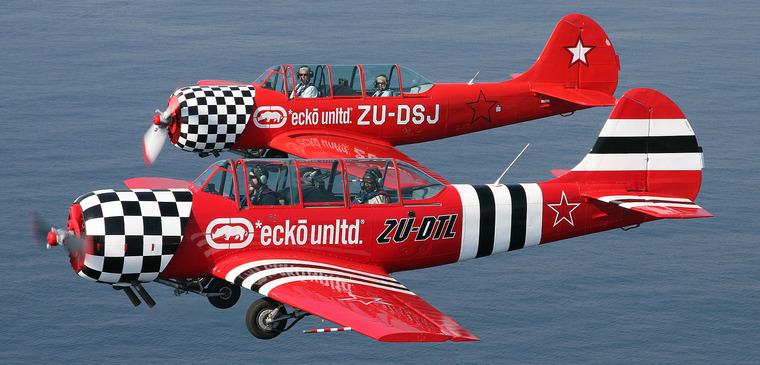 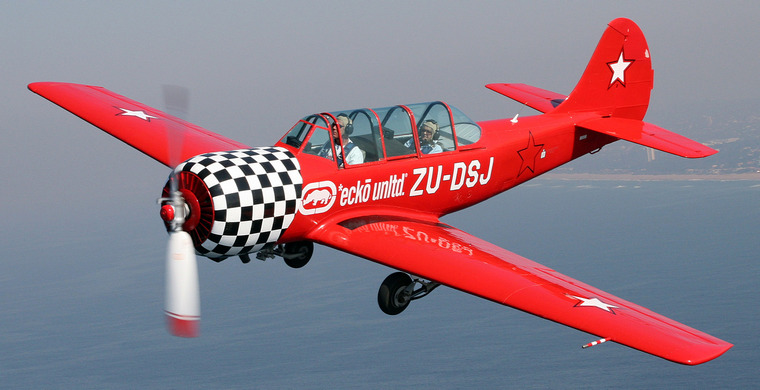 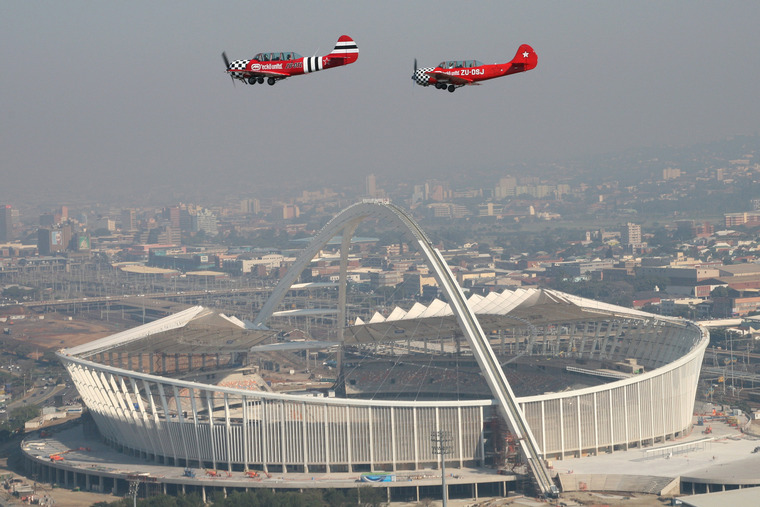 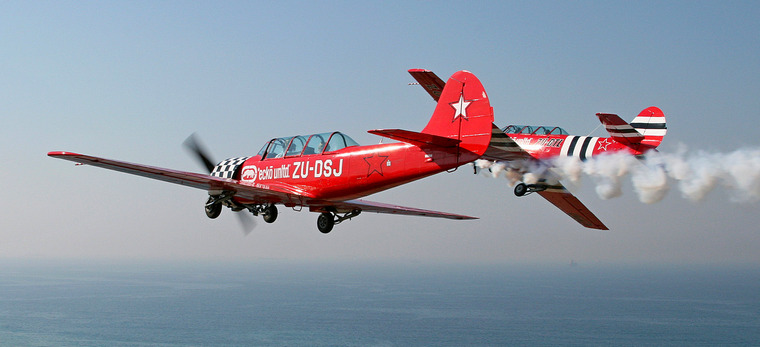 Thanks go to all concerned for the flights enabling the recording of these great memories. The meeting room at Acher was the site of pre-flight and post-flight briefings led by Stuart Low and Chris Esterhuyse. Contributions came from all participants. Formations were assigned and instructors were allocated and then the busy days began. 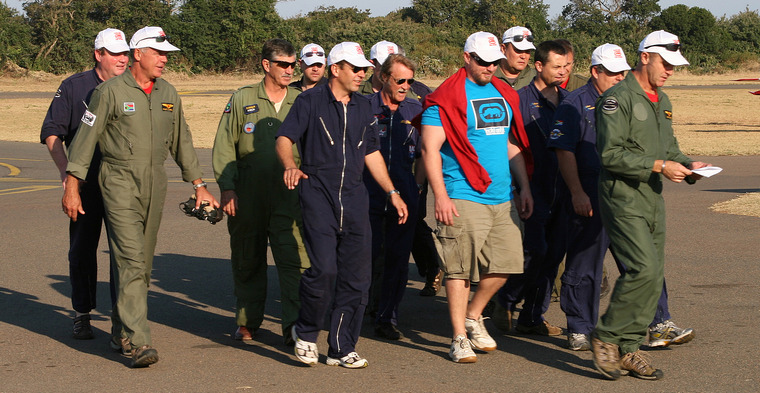 Walking through the formation Concentration was key and the Yak pilots were made to work hard at their skills. At the end of each day the group would gather at Durban Wings Club to wind down and discuss the day's adventures. Much fun was had by all.  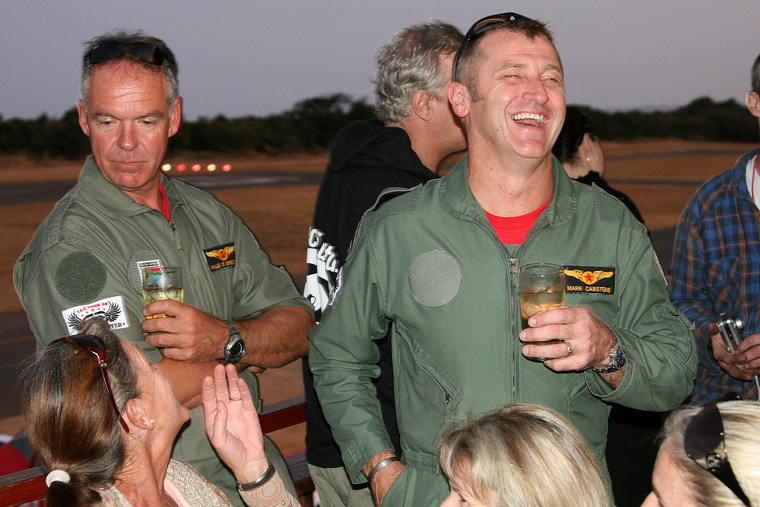 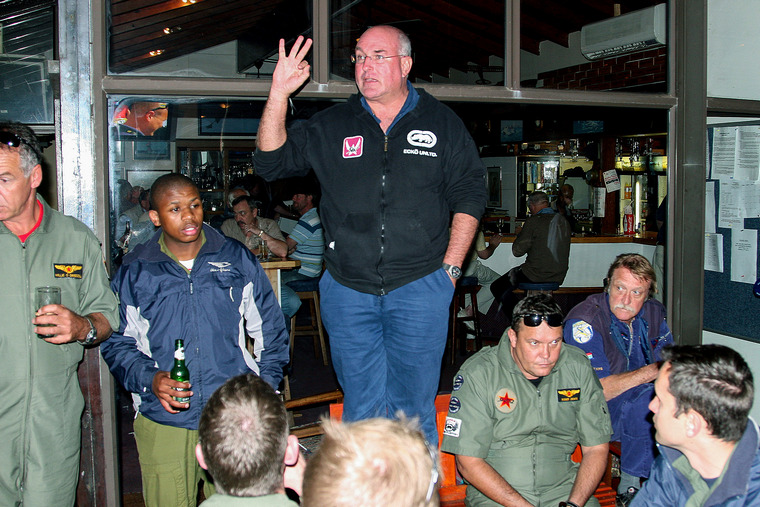 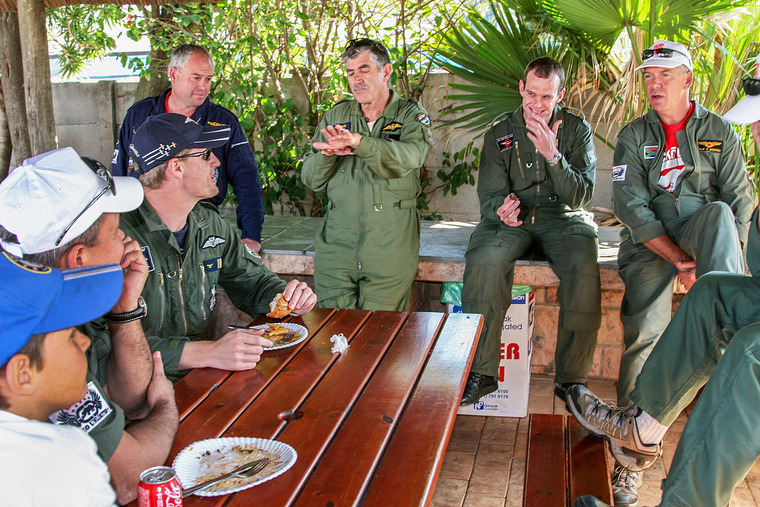 The aircraft: - As this is the last of the series, we thought it would be good to give a few facts about the two types of Yak flown. The Yak 52 is a tandem two seat trainer that is fully aerobatic. It first flew in 1976 and was built as a Russian primary trainer. It is powered by the 9-cylinder radial Vedeneyev M14P engine. The Yak was built to operate in harsh conditions for the Soviet military. It was designed to require minimal maintenance in the field. Unusually, many of the aircraft systems such as the starter, flaps, brakes and retractable landing gear operation all use compressed air. This has at times been a problem area, but the aircraft does have an emergency reserve. Additionally, both main and reserve bottles can be charged from a port on the ground with compressed air, usually from a Scuba type air bottle. Another unusual feature of the 52 is the fact that the landing gear does not retract fully. This means the aircraft can be landed on the wheels even in the retracted position in the event of an emergency or if gear deployment is forgotten. A good feature to have in a training aircraft and a few local pilots have inadvertently used this feature to avoid serious damage! The wooden propeller normally does not survive such a landing. The G force limits are 6.5 g positive and 3.2 g negative, depending on the all up weight. They are 7.745 m long, 2.7m high and have a wingspan of 9.3 m. They weigh 1015 kg empty and have a take-off weight of 1305 kg. Maximum speed is 285 kph and the cruising speed is 190 kph. It has a range of 550 kms and a service ceiling of 4000 m. 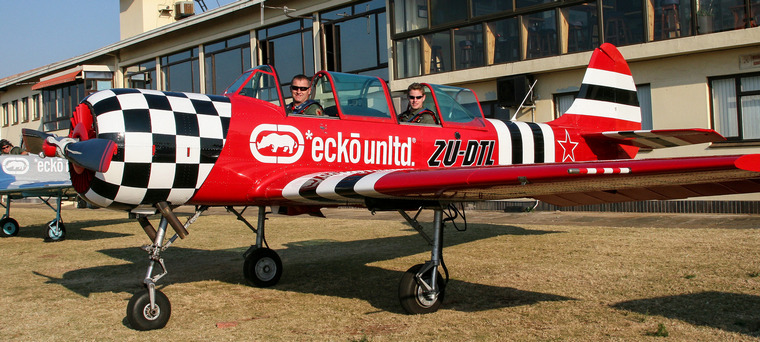 Mark Carstens and Scott Ternent in the 52 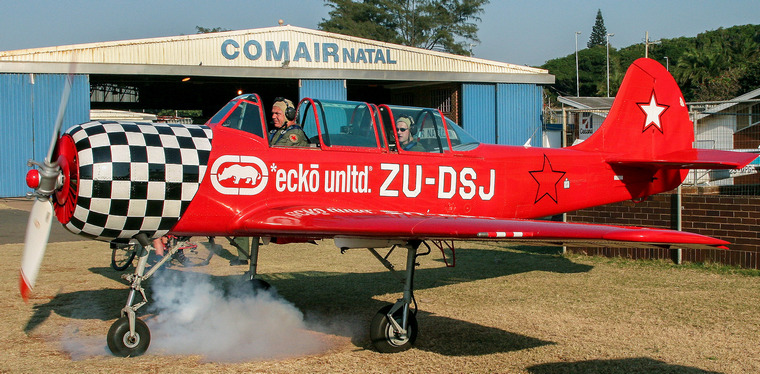 Typical Yak radial start! William O' Driscoll and Guy du Sautoy); 6803 (Mark Carstens in his Yak 52 The Yak 18T is a four-seat tricycle gear Russian trainer, initially used to train Russian airline pilots. It uses the same 9-cylinder radial Vedeneyev M14P engine as the Yak 52. The aircraft uses similar systems to the 52 and is also a fully aerobatic aircraft. This type first flew in 1967. The 18T has larger dimensions. They are 8.354 m long, 3.4 m high and have a wingspan of 11.16 m. They weigh 1217 kg empty and have a take-off weight of 1650 kg. Maximum speed is 262 kph and the cruising speed is 190 kph. It has a range of 740 kms and a service ceiling of 4000 m. 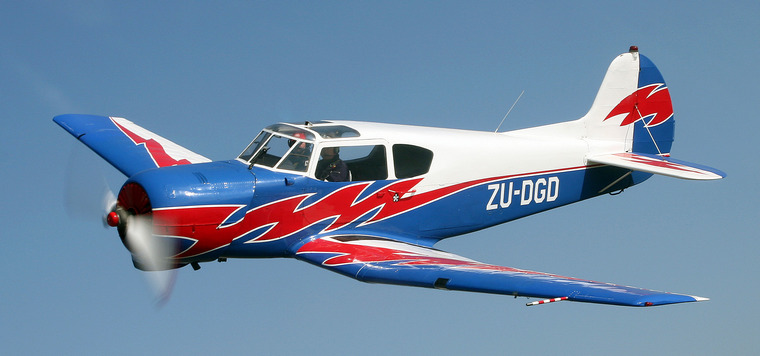 The 18T with Francois Davel concentrating hard with Mike Mason in the right-hand seat 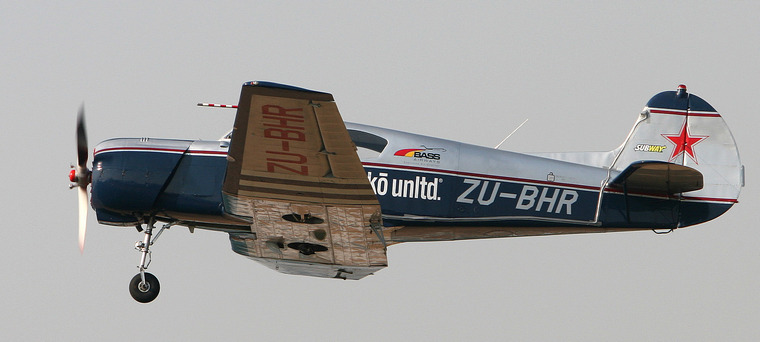 Brendan Adams' 18T 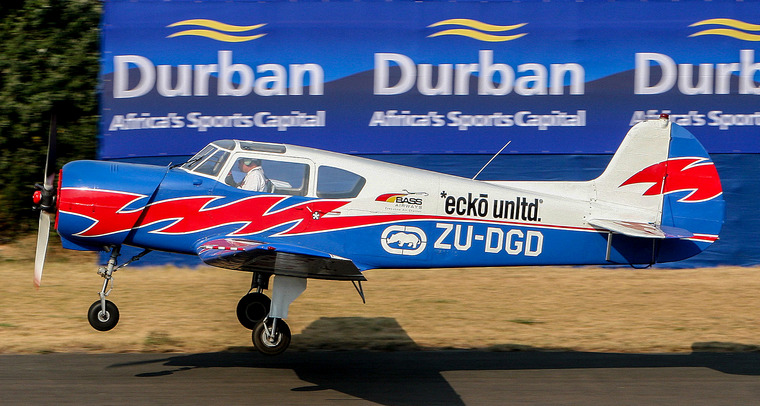 Francois Davel on air show day 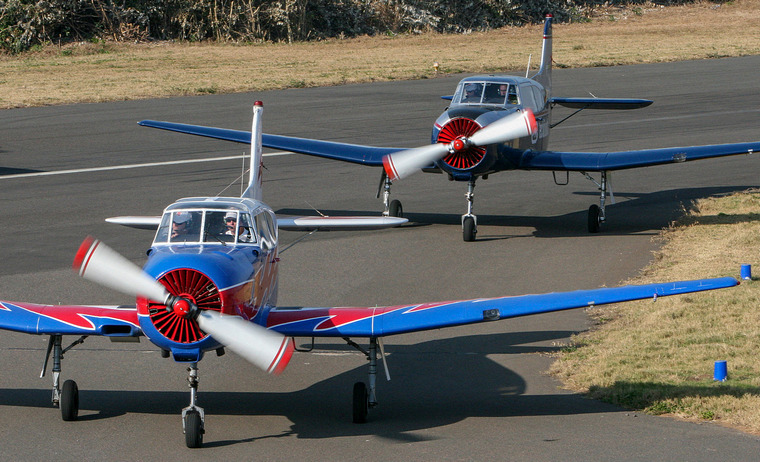 the two 18Ts about to turn back to take-off on runway 23 A recent look at the register showed that there are 52 Yaks in South Africa. A couple of those used in Yak Week have left the country. The current inventory of 52 is made up of 33 x Yak 52s, 12 Yak 18Ts and 7 Yak 55s. 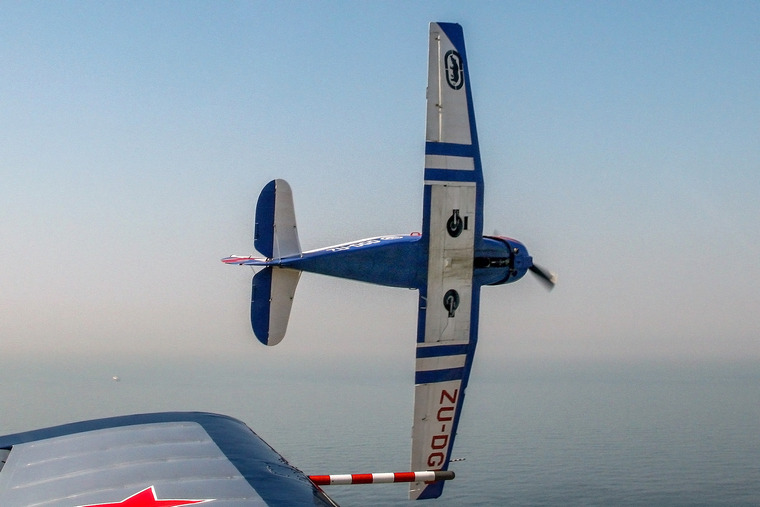 Francois Davel breaks in the 18T prior to landing at Virginia. 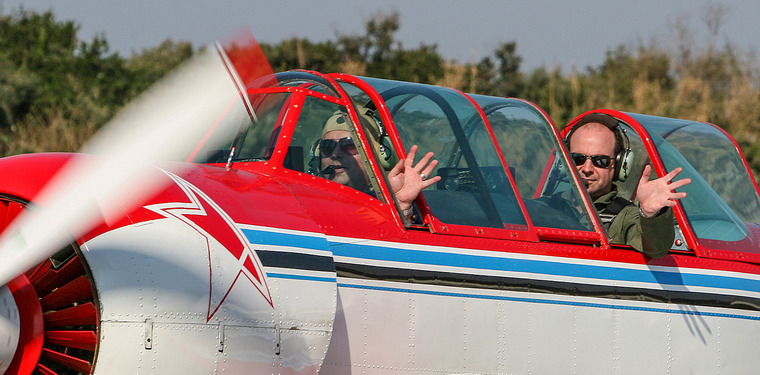 Yak 52 flown by Bruce Daniels with Duncan Gillespie at the back. 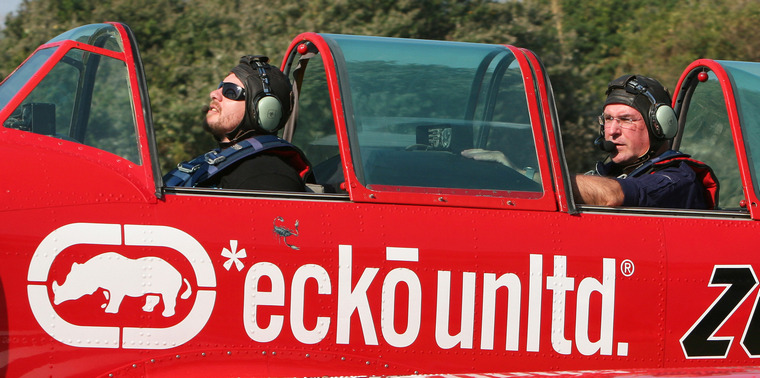 Yak 52 taxis out with Barrie Kruger in front and Stuart Low in the rear. 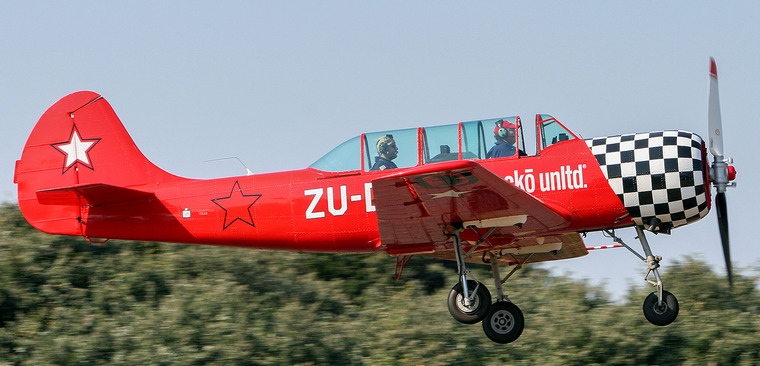 Alan Wight flies the 52 with Mike Mason behind. 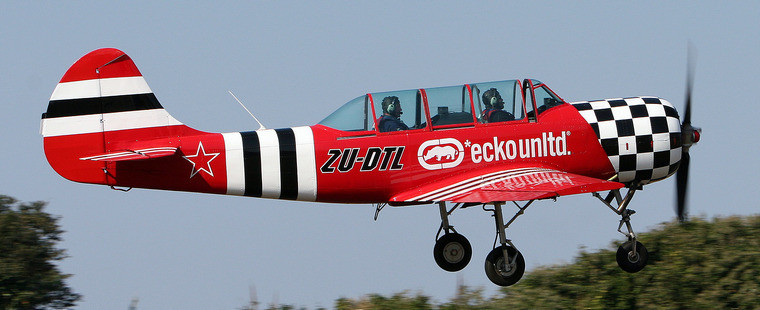 Barrie Kruger takes off with Stuart Low instructing. 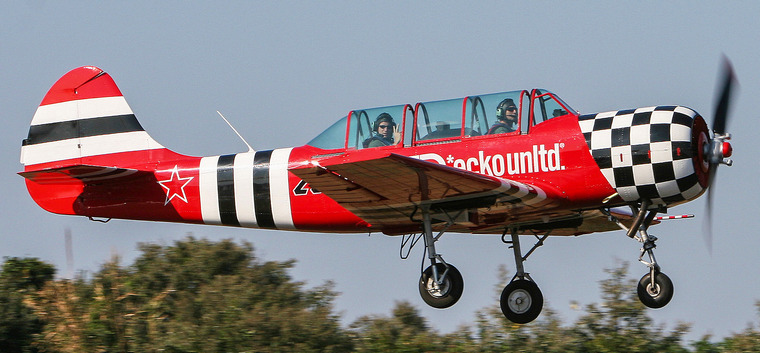 Mark Carstens and Scott Ternent. 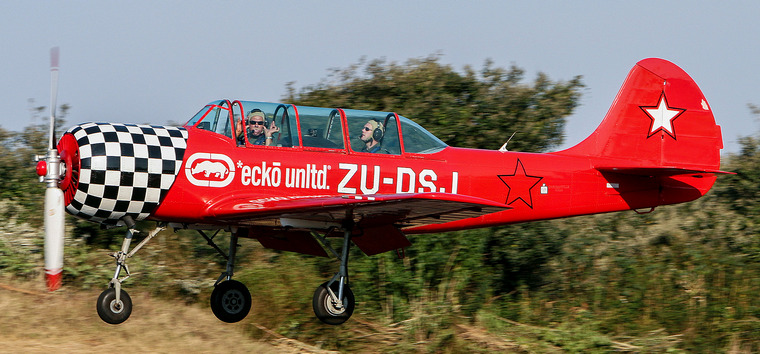 The “ever-serious” William O' Driscoll in front hamming it up for the photographer while Guy Du Sautoy lands from the back seat! 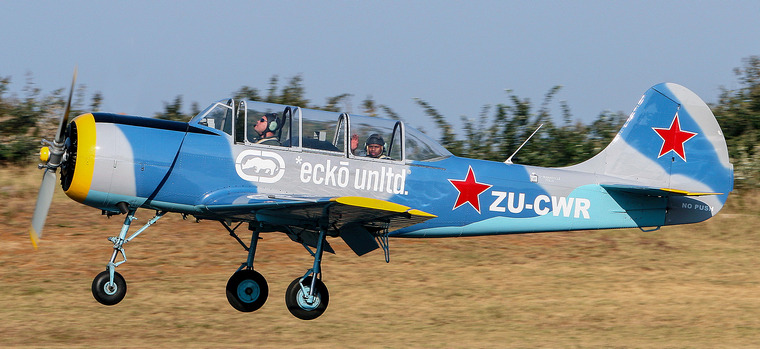 Roger Deare lands with Buti Tsebe giving the royal wave behind him. 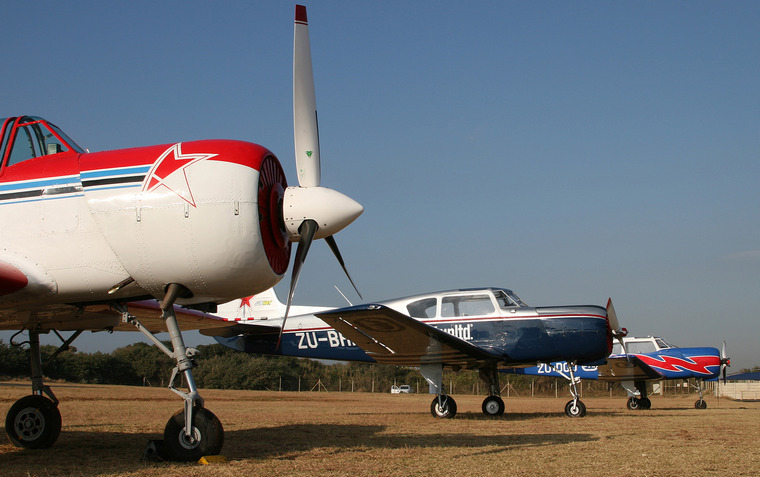 Morning line up. There was a similar four ship event in 2016. Sadly, the days of Yak Week have come to an end. Those that participated will never forget them and the formation flying lessons that greatly improved the skills of the pilots. Good days and fun times! Hopefully we can get back to this kind of action soon.  |
                                                 |
 |
 |

Copyright © Pilot's Post PTY Ltd
The information, views and opinions by the authors contributing to Pilot's Post are not necessarily those of the editor or other writers at Pilot's Post.